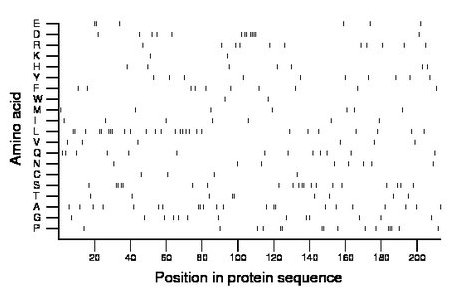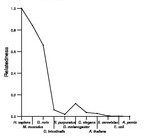
| Name: TTYH2 | Sequence: fasta or formatted (213aa) | NCBI GI: 53988387 | |
|
Description: tweety 2 isoform 2
|
Referenced in:
| ||
Other entries for this name:
alt prot [534aa] tweety 2 isoform 1 | |||
|
Composition:

Amino acid Percentage Count Longest homopolymer A alanine 10.3 22 2 C cysteine 1.9 4 1 D aspartate 6.1 13 4 E glutamate 2.8 6 2 F phenylalanine 4.7 10 1 G glycine 6.1 13 1 H histidine 3.3 7 1 I isoleucine 3.3 7 1 K lysine 0.9 2 1 L leucine 12.7 27 3 M methionine 3.3 7 1 N asparagine 3.8 8 1 P proline 7.5 16 3 Q glutamine 6.1 13 1 R arginine 5.2 11 1 S serine 9.4 20 2 T threonine 4.2 9 2 V valine 2.8 6 1 W tryptophan 0.9 2 1 Y tyrosine 4.7 10 1 |
Comparative genomics:
Search single species RefSeq proteins at NCBI
Search summary 
Figure data | ||
Related human proteins:Protein Relative score Description Self-match 1.000 tweety 2 isoform 2 TTYH2 1.000 tweety 2 isoform 1 TTYH3 0.343 tweety 3 TTYH1 0.229 tweety 1 isoform 1 TTYH1 0.179 tweety 1 isoform 2 BSN 0.019 bassoon protein CNTN2 0.017 contactin 2 precursor ZFR2 0.014 zinc finger RNA binding protein 2 isoform 1 ZNF366 0.012 zinc finger protein 366 KIF3C 0.012 kinesin family member 3C NFATC4 0.010 nuclear factor of activated T-cells, cytoplasmic, c... NFATC4 0.010 nuclear factor of activated T-cells, cytoplasmic, ca... LOC729159 0.010 PREDICTED: UPF0607 protein ENSP00000381418-like [Ho... ODZ2 0.010 odz, odd Oz/ten-m homolog 2 SOX10 0.007 SRY (sex determining region Y)-box 10 FAM83D 0.007 hypothetical protein LOC81610 FAM90A20 0.005 PREDICTED: hypothetical protein MAGEC1 0.005 melanoma antigen family C, 1 CLNS1A 0.005 chloride channel, nucleotide-sensitive, 1A FGD6 0.005 FYVE, RhoGEF and PH domain containing 6Human BLASTP results (used to prepare the table) | |||
Gene descriptions are from NCBI RefSeq. Search results were obtained with NCBI BLAST and RefSeq entries. When identical proteins are present, the self-match may not be listed first in BLASTP output. In such cases, the table above has been reordered to place it first.
See About the Figures for the scoring system used in the figure above right. The same scoring system was used in the table of BLASTP results.
Guide to the Human Genome
Copyright © 2010 by Stewart Scherer. All rights reserved.
